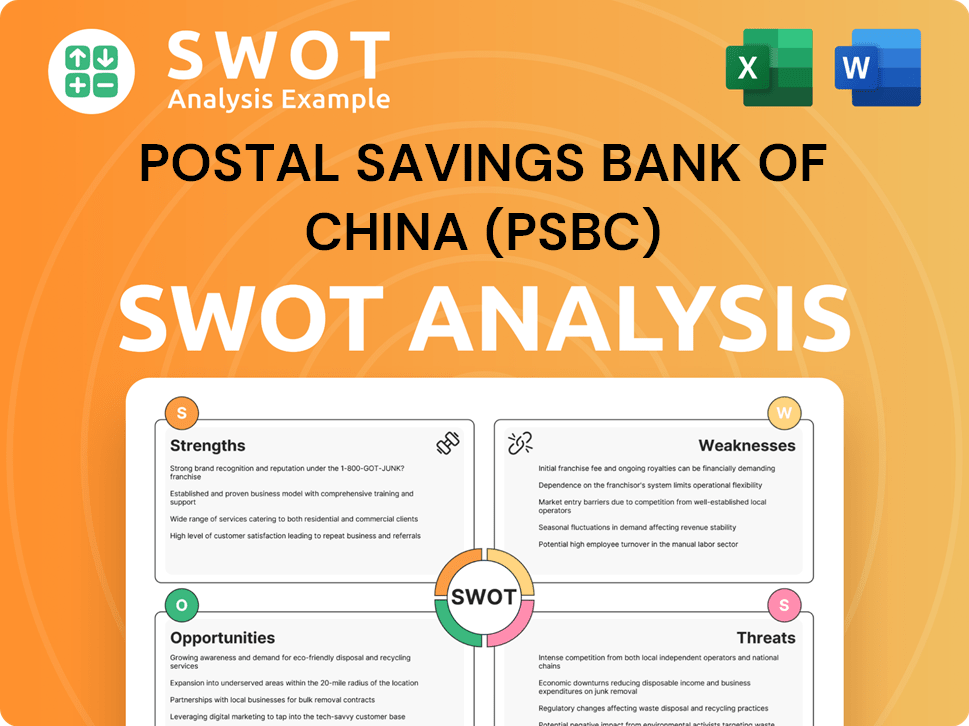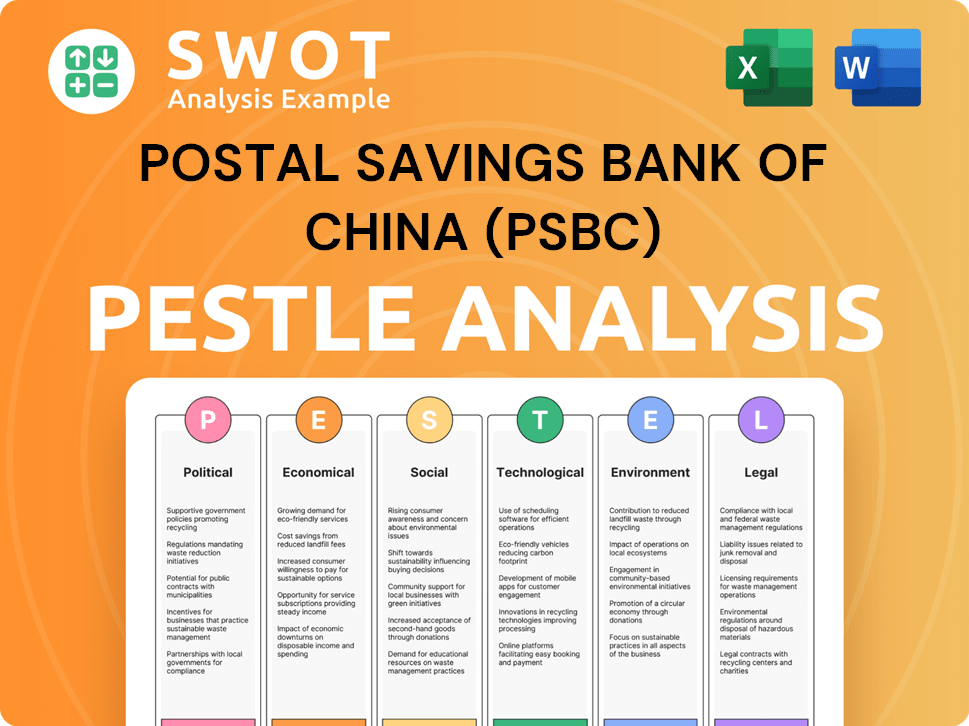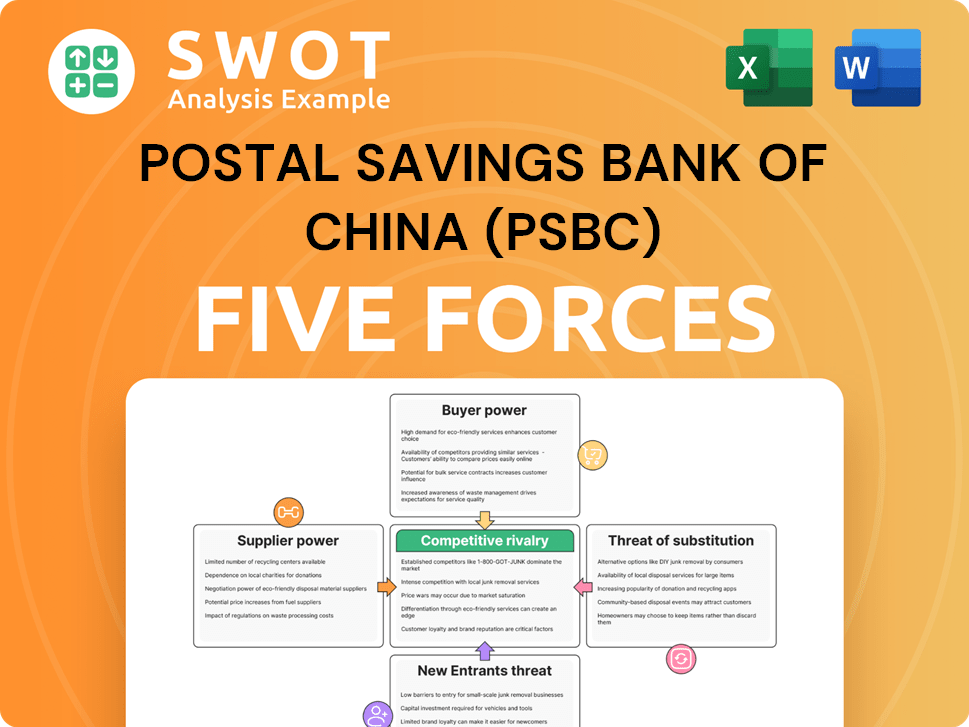Postal Savings Bank Of China (PSBC) Bundle
How Did Postal Savings Bank of China Rise to Financial Prominence?
Delve into the fascinating Postal Savings Bank Of China (PSBC) SWOT Analysis and uncover the remarkable story of PSBC, a financial powerhouse that has reshaped the Chinese banking landscape. From its humble beginnings to its current status as a leading retail bank, PSBC's journey is a testament to strategic vision and commitment to financial inclusion. Explore the key milestones and innovations that have shaped the brief history of Postal Savings Bank of China.

Founded on March 6, 2007, PSBC quickly established itself as a vital player in Chinese banking. Its unique approach, focusing on underserved populations and leveraging the existing postal network, set it apart from competitors. Understanding the evolution of PSBC, from its establishment date to its current market position, provides invaluable insights into China's financial institutions and economic development. This article will explore the brief history of Postal Savings Bank of China, its key milestones, and its strategic outlook.
What is the Postal Savings Bank Of China (PSBC) Founding Story?
The Postal Savings Bank of China (PSBC), a significant player in the Chinese banking sector, traces its roots back to the early 20th century. The official founding of PSBC on March 6, 2007, marked a pivotal moment, evolving from the long-standing postal savings operations that began in 1919.
The creation of PSBC was a strategic move to separate postal savings from the postal delivery service, streamlining financial operations. This separation was driven by the State Post Bureau and supported by the China Banking Regulatory Commission (CBRC), aiming to enhance financial inclusion across China.
The initial capital for PSBC was RMB 20 billion, provided by China Post Group. This financial backing underscored the bank's state-owned status and its mission to support national development, particularly in rural areas.
PSBC's establishment was a response to the limited financial reach of major commercial banks in rural China. The bank leveraged the extensive network of post office facilities, covering nearly 99% of Chinese counties.
- The primary goal was financial inclusion, focusing on underserved populations, including farmers and micro-entrepreneurs.
- The business model utilized a network of directly-operated and agency outlets in collaboration with China Post Group.
- Initial services offered were deposit and remittance services, capitalizing on the existing postal network's trust.
- PSBC's mission prioritized sustainability and social responsibility over immediate profit maximization.
Postal Savings Bank Of China (PSBC) SWOT Analysis
- Complete SWOT Breakdown
- Fully Customizable
- Editable in Excel & Word
- Professional Formatting
- Investor-Ready Format

What Drove the Early Growth of Postal Savings Bank Of China (PSBC)?
The early years of the Postal Savings Bank of China (PSBC) were marked by rapid expansion and strategic development. Following its establishment, PSBC leveraged China Post's extensive network to quickly build a significant presence in the Chinese banking sector. This period focused on establishing a robust corporate governance structure and extending its branch network across the country.
By February 2008, PSBC had established 36 primary branches, mainly at the provincial level. It also received approval for an additional 316 sub-branches and 20,089 service outlets. This rapid expansion was a key factor in PSBC's early growth, allowing it to quickly establish a broad customer base and operational footprint.
PSBC initially focused on serving rural areas and small and medium-sized enterprises (SMEs). This segment was largely underserved by other major commercial banks. PSBC launched deposit and loan products tailored for these customer segments, including micro and small enterprise loans and retail loans. This strategic focus helped PSBC differentiate itself in the competitive Chinese banking market.
A significant milestone was the transformation into a joint-stock limited liability company in January 2012. This move provided greater flexibility and attracted external investment. In December 2015, PSBC introduced ten strategic investors, including UBS, China Life, and Tencent, injecting a total of RMB 45.1 billion and acquiring a 16.92% stake. This capital raise strengthened PSBC's financial position.
PSBC's growth strategy was characterized by a differentiated approach, focusing on its unique network advantage and commitment to inclusive finance. Its extensive branch network, covering nearly 99% of counties, provided a distinct competitive edge. By the end of 2017, PSBC had nearly 40,000 branches covering all regions of China. For more information about the ownership structure, you can read about the Owners & Shareholders of Postal Savings Bank Of China (PSBC).
Postal Savings Bank Of China (PSBC) PESTLE Analysis
- Covers All 6 PESTLE Categories
- No Research Needed – Save Hours of Work
- Built by Experts, Trusted by Consultants
- Instant Download, Ready to Use
- 100% Editable, Fully Customizable

What are the key Milestones in Postal Savings Bank Of China (PSBC) history?
The Postal Savings Bank of China (PSBC) has a rich history marked by significant achievements and strategic developments. A key aspect of its History PSBC involves navigating the complexities of the Chinese banking sector while adapting to evolving market dynamics.
| Year | Milestone |
|---|---|
| September 2016 | PSBC completed its initial public offering (IPO) on the Stock Exchange of Hong Kong, raising HK$59.15 billion (US$7.58 billion). |
| December 2019 | PSBC was listed on the Shanghai Stock Exchange, further expanding its presence in the financial market. |
| 2023 | PSBC invested approximately CNY 2 billion in technology upgrades, resulting in the launch of its AI-driven credit assessment tool. |
| 2024 | The bank invested over CNY 15 billion in digital transformation initiatives, including IT infrastructure upgrades and enhancements to mobile banking applications. |
PSBC has been at the forefront of leveraging technology to enhance its services, showcasing continuous innovation in the Chinese banking sector. These innovations have allowed PSBC to improve its operational efficiency and customer service capabilities.
PSBC was among the first large commercial banks in China to adopt a core system based on an open platform, minicomputer cluster technology, and a distributed framework, put into operation in 2014. This enhanced the bank's technological infrastructure.
In 2023, PSBC launched an AI-driven credit assessment tool, following approximately CNY 2 billion in technology upgrades. This tool improved the accuracy and efficiency of credit evaluations.
In 2024, PSBC invested over CNY 15 billion in digital transformation initiatives, including upgrading IT infrastructure and enhancing mobile banking applications. This investment led to a 35% growth in active users.
PSBC participated in the preparation of the Report on Commercial Cryptography Application and Development in the Financial Industry (2023-2024). This participation enhanced the bank's security measures.
PSBC obtained an invention patent for 'Methods, Devices, and Storage Media for Secure Online Authentication of Mobile Terminal Devices.' This patent strengthened the security of online transactions.
PSBC developed an investment consulting assistant for wealth managers using AI models to enhance market research, customer analysis, and product evaluation capabilities. This tool improved the quality of financial advice.
Despite its achievements, PSBC faces several challenges, including the impacts of declining interest rates and increased competition within Financial institutions China. These factors have necessitated strategic adaptations to maintain profitability and market share. For more details, check out the Marketing Strategy of Postal Savings Bank Of China (PSBC).
PSBC, like other banks, has been affected by declining interest rates, which reduce net interest margins. This requires the bank to find new revenue streams.
The bank faces rising risks in retail loan quality due to the worsening retail credit cycle and intensified competition from large peers. This puts pressure on retail loan pricing.
PSBC's reliance on agency outlets, which contribute over 60% of total deposits, leads to higher funding costs. This impacts the bank's overall profitability.
In the past, PSBC faced issues such as a single structure of financial products, the need to improve risk management, and insufficient profitability of some products. This required the bank to diversify its offerings.
Intensified competition from large peers has put pressure on retail loan pricing. This requires the bank to differentiate its services.
PSBC has focused on strengthening its comprehensive risk management framework and digital transformation of risk management. This ensures the bank's stability and resilience.
Postal Savings Bank Of China (PSBC) Business Model Canvas
- Complete 9-Block Business Model Canvas
- Effortlessly Communicate Your Business Strategy
- Investor-Ready BMC Format
- 100% Editable and Customizable
- Clear and Structured Layout

What is the Timeline of Key Events for Postal Savings Bank Of China (PSBC)?
The History PSBC is marked by significant milestones, from its origins in 1919 to its status as a major financial institution today. The bank's evolution reflects China's economic growth and its commitment to serving both urban and rural communities. PSBC's journey includes strategic partnerships, public listings, and significant investments in technology, positioning it for continued growth in the evolving financial landscape.
| Year | Key Event |
|---|---|
| 1919 | The postal savings business, the precursor to PSBC, begins in China. |
| March 6, 2007 | Postal Savings Bank of China Limited is officially established with RMB 20 billion in registered capital from China Post Group. |
| February 2008 | PSBC establishes 36 primary branches and gains approval for over 20,000 field offices, expanding its network rapidly. |
| 2009-2010 | Registered capital increases to RMB 30 billion and then to RMB 41 billion through injections from China Post Group. |
| January 2012 | Postal Savings Bank of China Limited is transformed into a joint-stock limited liability company, renamed 'Postal Savings Bank of China Co., Ltd.' |
| December 2015 | PSBC introduces ten strategic investors, including UBS, Ant Financial, and Tencent, raising RMB 45.1 billion. |
| September 28, 2016 | PSBC lists its H shares on the Stock Exchange of Hong Kong, raising HK$59.15 billion (US$7.58 billion). |
| December 10, 2019 | PSBC lists its A shares on the Shanghai Stock Exchange. |
| 2020 | PSBC obtains approval for the establishment of PSBC online and establishes the Credit Card Center. |
| 2023 | PSBC invests approximately CNY 2 billion in technology upgrades and launches its AI-driven credit assessment tool. |
| 2024 | PSBC ranks 12th in The Banker's 'Top 1000 World Banks' and invests over CNY 15 billion in digital transformation initiatives. |
| April 2025 | PSBC commits to channel at least 10 trillion yuan in financing to private enterprises over the next five years. |
PSBC is focused on technology finance, green finance, inclusive finance, pension finance, and digital finance. The bank aims to expand its service points to 50,000 by the end of 2024, enhancing financial inclusion. The bank continues to deepen its pension finance service system and innovate product offerings for SMEs.
PSBC is investing heavily in digital transformation, with over CNY 15 billion allocated for these initiatives in 2024. The bank's AI-driven credit assessment tool, launched in 2023, supports its digital efforts. The bank has a strong focus on digital banking to enhance customer experience and operational efficiency.
PSBC has committed to providing at least 10 trillion yuan in financing to private enterprises over the next five years. This includes 3 trillion yuan for technology innovators and another 3 trillion yuan for modernizing agricultural operations. This commitment underscores PSBC's role in supporting key sectors of the Chinese economy.
In 2024, PSBC ranked 12th in The Banker's 'Top 1000 World Banks'. The bank serves over 90 thousand technology enterprises, with a financing balance exceeding RMB 500 billion, a year-on-year increase of over 40%. This demonstrates the bank's significant presence and growth within the financial sector.
Postal Savings Bank Of China (PSBC) Porter's Five Forces Analysis
- Covers All 5 Competitive Forces in Detail
- Structured for Consultants, Students, and Founders
- 100% Editable in Microsoft Word & Excel
- Instant Digital Download – Use Immediately
- Compatible with Mac & PC – Fully Unlocked

Related Blogs
- What is Competitive Landscape of Postal Savings Bank Of China (PSBC) Company?
- What is Growth Strategy and Future Prospects of Postal Savings Bank Of China (PSBC) Company?
- How Does Postal Savings Bank Of China (PSBC) Company Work?
- What is Sales and Marketing Strategy of Postal Savings Bank Of China (PSBC) Company?
- What is Brief History of Postal Savings Bank Of China (PSBC) Company?
- Who Owns Postal Savings Bank Of China (PSBC) Company?
- What is Customer Demographics and Target Market of Postal Savings Bank Of China (PSBC) Company?
Disclaimer
All information, articles, and product details provided on this website are for general informational and educational purposes only. We do not claim any ownership over, nor do we intend to infringe upon, any trademarks, copyrights, logos, brand names, or other intellectual property mentioned or depicted on this site. Such intellectual property remains the property of its respective owners, and any references here are made solely for identification or informational purposes, without implying any affiliation, endorsement, or partnership.
We make no representations or warranties, express or implied, regarding the accuracy, completeness, or suitability of any content or products presented. Nothing on this website should be construed as legal, tax, investment, financial, medical, or other professional advice. In addition, no part of this site—including articles or product references—constitutes a solicitation, recommendation, endorsement, advertisement, or offer to buy or sell any securities, franchises, or other financial instruments, particularly in jurisdictions where such activity would be unlawful.
All content is of a general nature and may not address the specific circumstances of any individual or entity. It is not a substitute for professional advice or services. Any actions you take based on the information provided here are strictly at your own risk. You accept full responsibility for any decisions or outcomes arising from your use of this website and agree to release us from any liability in connection with your use of, or reliance upon, the content or products found herein.